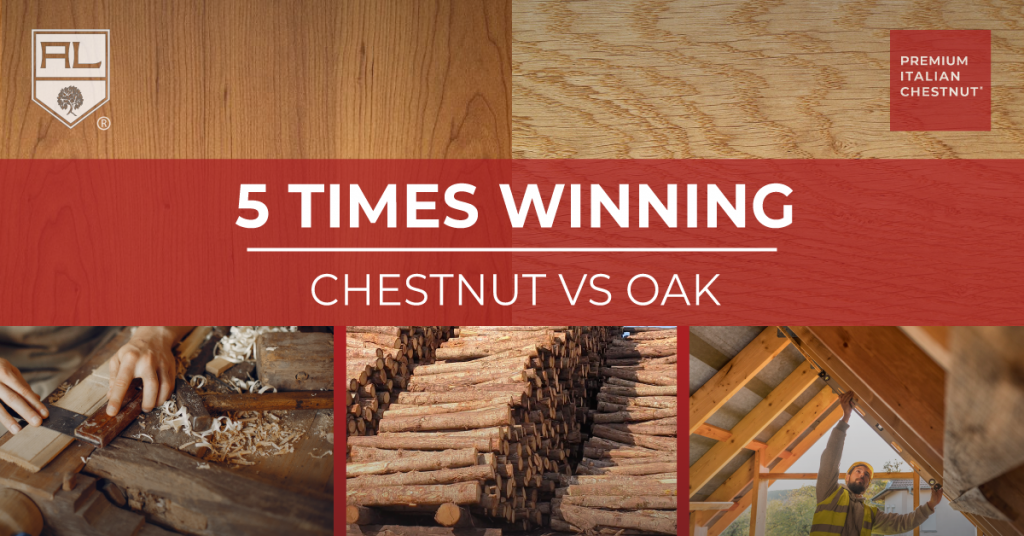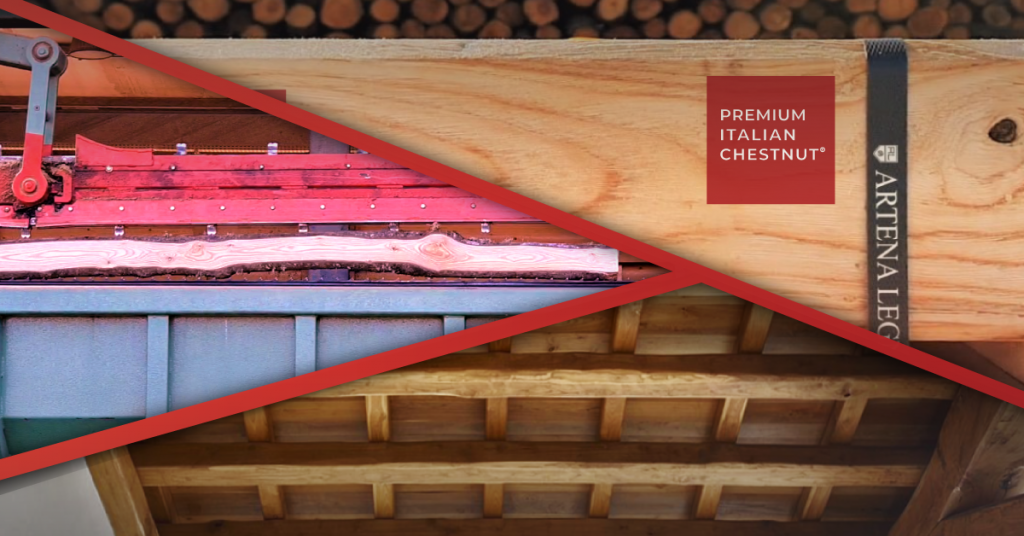
OAK AND CHESTNUT: PERFORMANCES COMPARING
No doubt about it! Exposed wood designed to support or furnish buildings of all kinds (domestic, public, commercial, industrial, sporting …) is a very common choice in the projects of engineers, architects and designers.
Today, as thousands of years ago, men are not immune to the natural charm of wood, so much so that it arouses deep feelings that vary according to the memories of the individual.
Without investigating more in human psychology and the emotional impact of wood on our sensibility (not to mention the sense of smell, which would certainly deserve a separate chapter, or rather a separate tome), the numbers speak for themselves: during the pandemic period from March 2020, production and general trade have recorded negative outcomes, while international demand for wood for structural and furnishing purposes has increased, with a consequent increase in prices of 232% (Fortune Magazine).
Among the needs of the moment, people look for the best solution, in terms of materials, for covering and renovating private and public structures. Not only in Italy, but all over the world and especially in Asian countries, the search for technical quality (resistance) and artistic profile (aesthetics) becomes such a need, sometimes maniacal, but not enough to overshadow the thought of economic commitment.
From the point of view of green design and green building, the demand for structural timber is, therefore, an important reality that leads customers to choose among the best woods at the right price-quality ratio. In the same way, the furniture market shows great interest in wood-desing and craftsmanship, so much that both modern products, where the raw material meets technological evolution, and the classic “hand-crafted” carpentry, are considered for many projects in a global level.
Let’s start with technical features (oak – chestnut)
Among the best wood species selected for these purposes, in the podium of broadleaf plants we can certainly find the chestnut and the durmast oak. Definitely the best choices considering the specific technical properties of both and the respective aesthetic peculiarities that characterize them. The identities of these two timbers are now well known to expert designers around the world, but there are substantial differences that lead us to express a preference.
Before delving into technical differences, it is important to remember that there are many varieties for every species, depending on the habitat identified around them. Chestnut and oak differ geographically according to the natural resources available in the territory, which influence the morphological growth of the plant and, ultimately, the quality of the wood.
A comparison, therefore, is valid since we are examining types with similar values and suitable for high quality standards for application in the structural field and for processing in the furniture sector. here it is, then, the profile of Premium Italian Chestnut (Castanea Sativa or Sweet Chestnut) analyzed in comparison with European Oak (Quercus petrae).
Leaving aside the differences and the morphological similarities of these two plants in their natural state, we will try to deepen the intrinsic peculiarities of the wood and the properties that affect the structural and aesthetic performance.
1. Density and specific weight (oak – chestnut)
Starting from the visual measurements recorded in the performance profiles, both timbers are attributed to class 2 of natural durability of wood (UNI EN 350:2016) as well as similar classes of mechanical strength – However, some analyses prove a higher strength (almost 80% more) of chestnut over oak. Two types of wood which are highly durable and resistant, but an important difference can be found in the post seasoning density: oak, with a specific weight of 960 kg/m³ turns out to be much heavier than chestnut, of 580 kg/m3. With a much lower density, the lightness of chestnut, together with its high resistance, represents one of the great advantages for the structural design of roofs and attics.

2. Hygroscopicity, deformity and expansion (oak – chestnut)
The observation of the specific weight also helps us to understand the ability of wood to react to the load of water inside it. Generally, the wood tends to release most of its moisture during the seasoning period and to manage the water exchange with the surrounding air throughout its use (especially if applied in solid form as structural warping) but not all timbers act in the same way.
The absorption and release of moisture (hygroscopicity) of oak is a relatively slow process due to its microstructure, while in chestnut products the porous and flexible configuration allows a continuous and relevant exchange of water particles even in extreme situations and, among other things, without altering the state of the wood over time.
Talking about deformities, let’s deal with a delicate topic for oak wood which is sensitive to dimensional changes in presence of excessive changes of humidity rate in the environment. Shrinkage and expansion, if intensely manifested, could then lead to structural problems that should be considered and avoided already in the design phase during the choice of the material to be applied.
3. Supply and Sustainability
The geographical distribution of chestnut coppice forests, registered and protected at European level, allows a precise and immediate identification of the best silvicolture, thus facilitating the supply of the selected quality. Premium Italian Chestnut comes from certified and recognized cultivations according to the strict regulations for the woodlands management. The greater attention in safeguarding this resource is justified by its ability to reproduce and develop rapidly.
Therefore, since chestnut trees grow faster than oak trees, the material can be harvested and processed at higher rates, ensuring greater productivity and, at the same time, operating within the permitted limits. In this way, the territory is protected while respecting the standards of environmental sustainability.
4. A thin sapwood and a big heart
Another substantial difference between the two species lies in the formation of sapwood and heartwood in the plants. The chestnut tree has a limited portion of sapwood, in the outer part of the section, characterized by soft and delicate texture, intended for the circulation of sap and water. Sapwood can be easily attacked by fungi and insects and while a chestnut section shows a limited portion, an oak section shows it larger, making handwork more difficult.
Chestnut has, consequently, a more developed inner portion, the heartwood. The hardest part but at the same time with a density favorable to handcrafting. Its resistance guarantees a high protection against fungal and insect attacks, giving an excellent durability both for structural and furnishing applications.
5. The artistic side
“Dulcis in fundo”, the aesthetics of wood product in design projects is a fundamental element. The artistic side of the product is given by the texture and the reaction to light on the surface. Chestnut, when deprived of its excess moisture, gives a much creamier color than oak, with brown streaks, not detectable in oak products. In other cases, the wood can take on a strong ochre color resulting from the high concentration of tannin, very often appreciated in classic and modern style projects.
The grain is actually a real characteristic since it is quite coarse, excellent for large expanses on tables or worktops and absolutely original in structural products, especially when applied in solid form that preserves its natural pattern.
Click HERE to learn more about our Premium Italian Chestnut®. Also, follow us on our Facebook and Instagram pages for news and insights on the Chestnut Culture.
Don’t miss our other publications:
AUTHENTIC STRUCTURAL MATCHBOARDS
CHESTNUT STYLE – CLASSICAL, RUSTIC, MODERN.
50 SHADES OF CHESTNUT
THE 5 PILLARS OF SUSTAINABILITY – PEFC
CE MARKING CHESTNUT TIMBER
7 REASONS TO CHOOSE SOLID CHESTNUT



